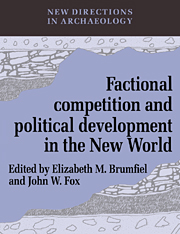Book contents
- Frontmatter
- Contents
- List of figures
- List of tables
- List of contributors
- Preface
- PART I INTRODUCTION
- PART II CHIEFDOMS
- PART III STATES
- 7 Ethnicity and political control in a complex society: the Tarascan state of prehispanic Mexico
- 8 Ethnic groups and political development in ancient Mexico
- 9 Factional divisions within the Aztec (Colhua) royal family
- 10 Alliance and intervention in Aztec imperial expansion
- 11 Political factions in the transition from Classic to Postclassic in the Mixteca Alta
- 12 Internal subdivisions of communities in the prehispanic Valley of Oaxaca
- 13 Cycles of conflict: political factionalism in the Maya Lowlands
- 14 Political cosmology among the Quiché Maya
- 15 Factions and political development in the central Andes
- PART IV DISCUSSIONS
- Bibliography
- Index
12 - Internal subdivisions of communities in the prehispanic Valley of Oaxaca
Published online by Cambridge University Press: 18 December 2009
- Frontmatter
- Contents
- List of figures
- List of tables
- List of contributors
- Preface
- PART I INTRODUCTION
- PART II CHIEFDOMS
- PART III STATES
- 7 Ethnicity and political control in a complex society: the Tarascan state of prehispanic Mexico
- 8 Ethnic groups and political development in ancient Mexico
- 9 Factional divisions within the Aztec (Colhua) royal family
- 10 Alliance and intervention in Aztec imperial expansion
- 11 Political factions in the transition from Classic to Postclassic in the Mixteca Alta
- 12 Internal subdivisions of communities in the prehispanic Valley of Oaxaca
- 13 Cycles of conflict: political factionalism in the Maya Lowlands
- 14 Political cosmology among the Quiché Maya
- 15 Factions and political development in the central Andes
- PART IV DISCUSSIONS
- Bibliography
- Index
Summary
This study examines archaeological and historical information on segmentation at the community level in the prehispanic Valley of Oaxaca. Some communities had internal, spatial subdivisions, though it is usually not possible with the present information to specify the basis on which these communities were subdivided. By and large, however, Valley of Oaxaca communities were politically centralized rather than segmental.
Class, stratification, or status hierarchy distinctions pervaded Oaxacan and Mesoamerican societies generally. Elsewhere our settlement pattern project has written about problems in the archaeological identification of these class distinctions (Kowalewski, Feinman, and Finsten in press). In reality hierarchical distinctions between levels are intertwined with same-level distinctions, such as factions; nevertheless, I would like to treat just the same-level groupings in this chapter.
The most significant same-level distinctions in Valley of Oaxaca society were not within communities; nor did kinship or ethnicity generate the major factions of society. Instead, on the whole, inter-community divisions were the major segments whose binding or separation was crucial to the dynamics of society. These inter-community fault lines contrast with the segmentary lineages proposed for the Maya area (Wallace and Carmack 1977, Fox 1987). In this respect Valley of Oaxaca society was more similar to that of Central Mexico than to Maya society. Yet the Valley of Oaxaca lacked the apparent emphasis on ethnic constituents seen in Postclassic Central Mexico.
The remainder of this chapter provides support for the propositions I have just made. The next five sections describe the several lines of evidence bearing on community subdivisions generally in the Valley of Oaxaca, and especially subdivisions at the two sites, San José Mogote and Monte Albán, where subdivisions are most obvious.
- Type
- Chapter
- Information
- Factional Competition and Political Development in the New World , pp. 127 - 137Publisher: Cambridge University PressPrint publication year: 1994
- 1
- Cited by



